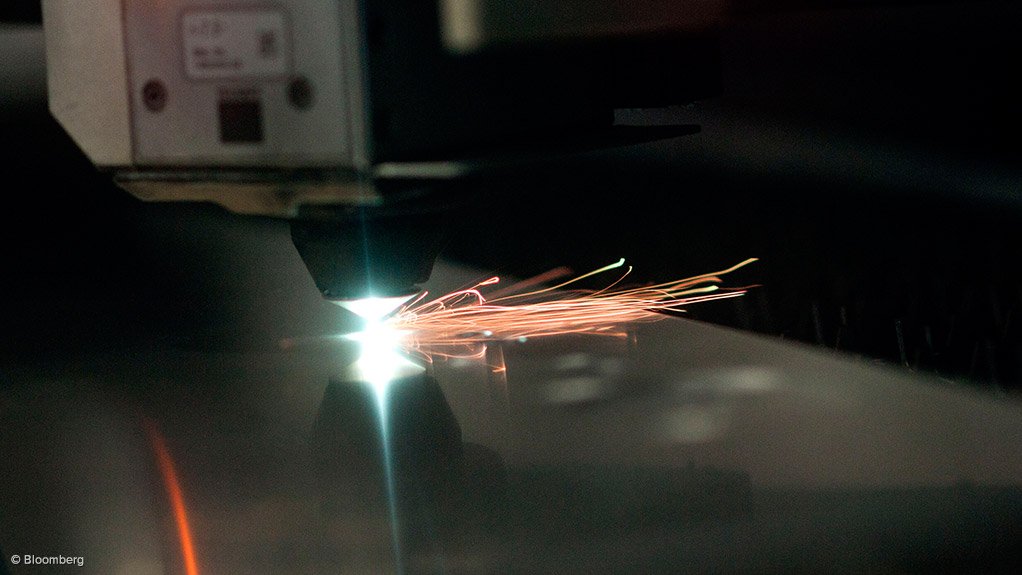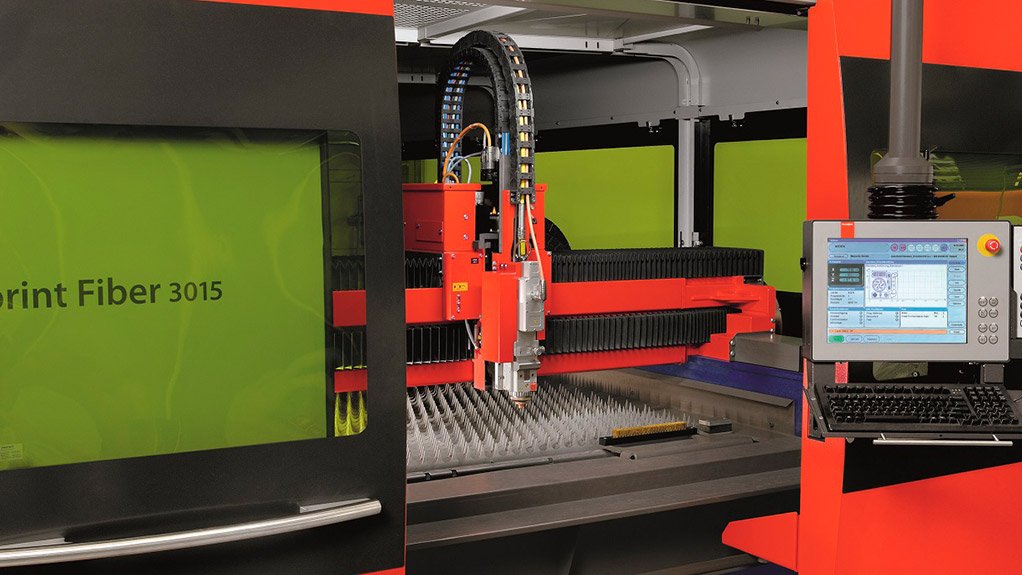Laser industry shifts to fibre laser-cutting systems



IMPROVED PROFICIENCY The speed of a fibre laser is several times higher than that of a CO2 laser
Photo by Bloomberg
POWER LURE The majority of the fibre lasers delivered to South African companies include fibre laser systems that range from 2 kW to 6 kW
The laser-cutting industry has transitioned in recent years from using carbon dioxide (CO2) lasers to fibre laser-cutting systems, notes Switzerland-based sheet metal cutting and bending equipment supplier Bystronic.
The light source of a fibre-optic laser- cutting system, commonly known as fibre lasers in the industry, is created by diodes. This light is channelled and amplified through a fibre-optic cable and, on exiting the cable, it is straightened and focused by a lens onto the material to be cut. The laser requires no optical mirrors, while the focusing lens is sealed in the cutting head.
Bystronic’s range of manufactured CO2 and fibre laser-cutting machines include, but is not limited to, the BySprint, BySprint Pro, Bysprint Fibre and Byspeed Pro laser systems; the company also provides laser resonators and power sources.
Meanwhile, Bystronic Central Europe market division senior VP Hugo Allemann notes that, according to research, cutting ferrous and nonferrous metals with nitrogen gas, in particular, increases the speed of the fibre-laser technology.
“If the same material is cut, the speed is several times higher than that of a CO2 laser. This is definitely a good reason why fibre laser-cutting machines have had increased success in the metals industry over the past few years,” he says, adding that another key driver for this particular technology’s success is the reduced maintenance requirements.
Further, fibre lasers use markedly less electricity than CO2 lasers, providing increased energy savings, says Allemann. He further points out that the degree of efficiency of a fibre laser is more than 30%, which means that 30% or more of the energy used by the machine is transferred to the metal plate, while the degree of efficiency for a CO2 laser is only 14%.
Fibre lasers can also cut copper, brass and aluminium better and more safely than CO2 lasers, as the beam is readily absorbed and not reflected.
Additional advantages of fibre lasers include the absence of beam path bellows that are necessary in CO2 systems, low operating costs, owing to wear-free semiconductor excitation, and wear-free magnetic bearing compressors.
Most of the fibre lasers delivered to South African companies include fibre laser systems that range from 2 kW to 6 kW and format platforms ranging from 3 m × 1.5 m up to 4 m × 2 m. However, the 6 kW Bysprint fibre laser is gaining traction in the industry, adds Allemann.
Meanwhile, cutting consumables and capital equipment supplier First Cut technical sales representative for Bystronic in South Africa Garth Haigh agrees that fibre lasers represent the fastest-growing sales category, which includes, but is not limited to, fibre laser systems like the Bysprint fibre laser.
The Bysprint fibre laser-cutting machine can cut sheet sizes of 3 000 mm × 1 500 mm and features a maximum simultaneous positioning speed of 140 m/min, with a maximum axis acceleration of 12 m/s2.
With customer and industry demand for CO2 lasers determining the future of this particular technology, Allemann does not believe that the use of CO2 lasers will completely disappear, owing to their offering several advantages. “It is more economical to cut thick and large formats or sizes of certain materials using CO2 lasers,” he adds.
Moreover, Bystronic US product marketing head Frank Arteaga says CO2 lasers are still the most widely used and broadly sold cutting systems on the market.
“The reputation of CO2 lasers has been established over several years and, while the leaps in process technology have benefited fibre lasers, there have also been important enhancements in CO2 laser-cutting systems,” he noted in a February 2013 issue of Fabricating & Manufacturing magazine.
Nevertheless, Allemann believes that most of the technology and research regarding CO2 lasers has been explored and developed, with no distinctive leap in innovation expected in future.
“However, there is still room for development in fibre-laser technology, as it is in its infancy stage,” he says.
Allemann explains that a CO2 laser can easily meet the requirements of cutting thicker material in various formats. However, a fibre laser-cutting machine should be considered if a company is considering any laser-cutting machine additions to its facilities, owing to the material degree of competitiveness it provides in terms of speed and efficiency.
“When it comes to format and resonator size, CO2 and fibre laser-cutting machines also compare well in terms of capital cost,” he says, adding, however, that the operational costs of the fibre laser-cutting machine are lower.
Although fibre laser cutters can currently only cut sheet metal of up to 4 m × 2 m, Allemann believes that the format size for cutting sheet metal is not a challenge. “Rather, it is a question of priority with regard to what sizes and formats for fibre laser-cutting machines should be designed, how they can be further developed and manufactured, in what timeframe and according to customer demand.”
While Bystronic has not yet disclosed plans to introduce a new format or power-size fibre laser-cutting machine this year, Allemann concludes that the future for fibre laser cutters remains promising, with possible new strides to be made in future.
Article Enquiry
Email Article
Save Article
Feedback
To advertise email advertising@creamermedia.co.za or click here
Comments
Press Office
Announcements
What's On
Subscribe to improve your user experience...
Option 1 (equivalent of R125 a month):
Receive a weekly copy of Creamer Media's Engineering News & Mining Weekly magazine
(print copy for those in South Africa and e-magazine for those outside of South Africa)
Receive daily email newsletters
Access to full search results
Access archive of magazine back copies
Access to Projects in Progress
Access to ONE Research Report of your choice in PDF format
Option 2 (equivalent of R375 a month):
All benefits from Option 1
PLUS
Access to Creamer Media's Research Channel Africa for ALL Research Reports, in PDF format, on various industrial and mining sectors
including Electricity; Water; Energy Transition; Hydrogen; Roads, Rail and Ports; Coal; Gold; Platinum; Battery Metals; etc.
Already a subscriber?
Forgotten your password?
Receive weekly copy of Creamer Media's Engineering News & Mining Weekly magazine (print copy for those in South Africa and e-magazine for those outside of South Africa)
➕
Recieve daily email newsletters
➕
Access to full search results
➕
Access archive of magazine back copies
➕
Access to Projects in Progress
➕
Access to ONE Research Report of your choice in PDF format
RESEARCH CHANNEL AFRICA
R4500 (equivalent of R375 a month)
SUBSCRIBEAll benefits from Option 1
➕
Access to Creamer Media's Research Channel Africa for ALL Research Reports on various industrial and mining sectors, in PDF format, including on:
Electricity
➕
Water
➕
Energy Transition
➕
Hydrogen
➕
Roads, Rail and Ports
➕
Coal
➕
Gold
➕
Platinum
➕
Battery Metals
➕
etc.
Receive all benefits from Option 1 or Option 2 delivered to numerous people at your company
➕
Multiple User names and Passwords for simultaneous log-ins
➕
Intranet integration access to all in your organisation


















